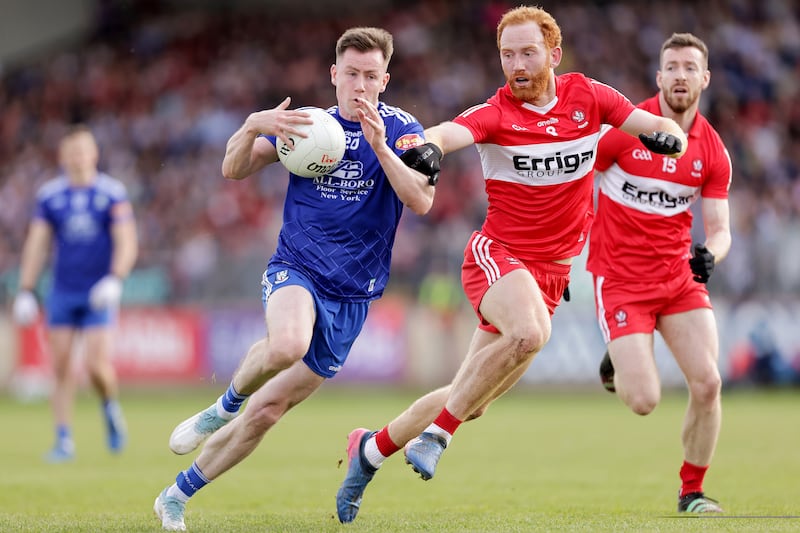We are now past the halfway point of the intercounty season. Time is becoming more finite. Tuesday’s draw for the innovative All-Ireland series has given everyone a sense of what the rest of their year will look like. Different venues, different styles, different atmospheres. Different pressures.
Seven weeks from now, all but 10 counties will be done for the year – eight in the race for Sam Maguire and the two Tailteann Cup finalists. All the work done since late last year has no more than a handful of 70-minutes performances left to be reflected. With the clock ticking, the ability to do physical and tactical work will be replaced by recovery, managing training loads and staying mentally sharp.
This week I wanted to look around the corner. There is always something you can do to improve performance. Here are three areas that teams could invest in discreetly in the coming days and weeks.
1) Trust
Last weekend Dublin forced Kildare long on their own kick-out nine times. From this, Dublin scored three points. The amount of work required to stay linked together to force a turnover on a kick-out cannot be understated. It’s really complex.
Seán Moran: League’s championship promise may be clouding but it remains bright at the top
Malachy Clerkin: The GAA should make more of St Patrick’s Day - and more of its intercounty stars
Sports Review 2023: Mary Hannigan picks the best quotes from the sporting year
GAA happy that GAAGo has ‘bedded in well’ as 2024 season launches
There could be up to 15 feasible options for a goalkeeper over a 12-second period. The attacking team will look to draw you in to exploit a space. As the defending team, you need to protect dangerous spaces by working in unison.
You need to respond to shut down any threat, while at the same time making sure not be duped into allowing the goalkeeper set up an optimal platform to attack. Don’t forget that for the most part you can’t hear in the big moments. There is limited audible communication.
This is where trust plays a big role. Forcing a turnover requires a high level of understanding, football intelligence and importantly a deeper level of trust. Teams that progress further into summer football will exhibit this deeper level of trust across all areas of their game, often only really tested in the more pressurised of moments.
A few years ago, I undertook a thought-provoking thesis in the DCU Business school under the guidance of world-renowned professor Finian Buckley. My study explored the phenomenon of Trust and specifically Felt-Trust. In short, trust is the basis for all social exchanges. It really does matter.
Something happens at a neurochemistry level. A chemical release happens when trust is formed and exchanged with people. Oxytocin is released in the brain. For a comparison, think of when you exercise – endorphins are released in your brain which make you feel brilliant.
For GAA players, developing this trust is grown in two main ways – shared experiences and opportunities for people to show self-expression. Although training and games will provide both, outside of that there are more opportunities.
Players might do a social activity together, lightening the atmosphere and spending time in each other’s company. Players might discretely show thoughtfulness towards a specific life event such as a job promotion – leaving a congratulations card in a team-mate’s gear bag. Or a simple and effective way is to just to listen to someone, allowing others to playback their thoughts without judgment. Listening to understand, not listening to reply.
2) Conversations
This is the point in the season where a fork in the road starts to appear. The quality of conversation between players should be consistently high. The game is simple, so keep language simple.
For example, last weekend Monaghan had a 54 per cent scoring conversation rate. Linked to this could be the significant pressure they were put under – demonstrated through the 15 turnovers Derry got inside their own 45-metre line close to their own goal.

In this case conversations could be around why this happened. Was it a technical error? Mentally was it the wrong decision? Tactically, did they not expect what they encountered? Or they did expect the pressure, but players deviated from the plan?
It is important that players form their thoughts in a non-emotive way. That helps crystallise the point. Sharing these with others feeds clarity – is it a trend, a one-off event or something relevant to a unique play?
Everyone has busy lives – players, coaches, support staff. So time is of the essence. Ideally you want people speaking in sentences, not paragraphs.
3) Deliberate practice
Once the conversations between players are of high quality, it should then translate to specific design of a pitch practice. Take those Monaghan players reviewing the trend of having 15 turnovers inside the opposition 45. The insight here might be that on too many occasions the Monaghan player decided to risk it. Bringing the ball too close into contact.
A subsequent pitch session is designed in some respects to practice not taking the ball into contact. Critically, this extends to what a player needs to do at an individual level too. Where players will apply personal concentration to an area without distractions of a team around them.
[ Jonny Cooper: Subtle plays decide just as many games as spectacular onesOpens in new window ]
In the same example used above, let’s say that numerous Monaghan players made the wrong decision, bringing the ball in to contact to force a turnover. Look and learn from any top-level performers beyond GAA. Specifically, one that deals with pressure, space and decision making.
World chess champion for nine consecutive years, Magnus Carlsen, speaks about the power and benefit of visualisation. Helping to understand spatial movements and pressure moments before they arise, allowing him to make better decisions when they appear.
Visualisation has the added advantage in reducing physical loads for GAA players. Like Carlsen, many GAA players use visualisation, mentally putting themselves in scenarios. Choosing a positive action when encountering bodies in restricted spaces. These are essentially mental repetitions of moving at speed with the ball – just not actually physically doing it.
The bottom line is different formulas will work in different environments. The mood, energy levels, years of experience and types of goals will ultimately dictate what’s important for each group. What will make a difference for teams? Trusting each other, talking to each other, targeting specific improvements.
All while the clock ticks down.






